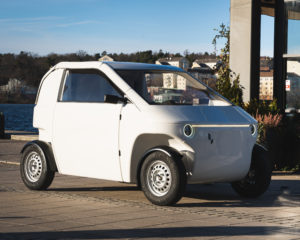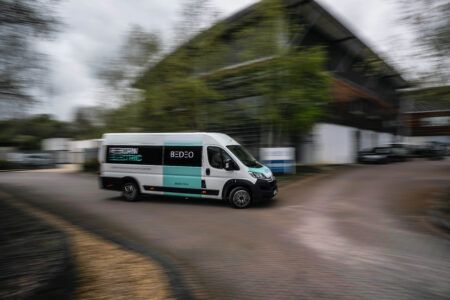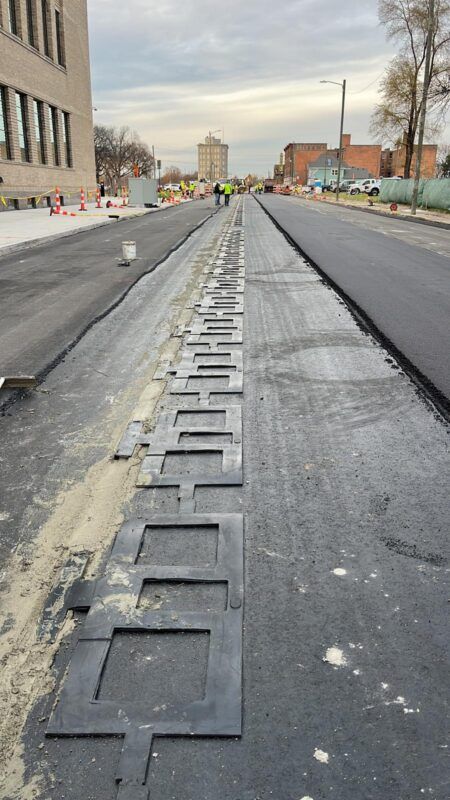Words Benedict Evans
The emergence of legislative and societal shifts in favour of a safer and more sustainable means of intra-city travel is good news for those looking to re-mould transport options. But what does the future of intra-city travel look like? Luvly, a Stockholm-based technology company, think they know: the Luvly O – a light urban vehicle (LUV) designed and assembled in Sweden. Founded over 15 years ago, Luvly recently announced the launch plans for the Luvly O on the world stage, having up until that point remained taciturn about the details of its components and capabilities.
“Luvly O is a vehicle designed for the urban citizen,” says Håkan Lutz, Luvly CEO and founder, “It’s small but spacious and easy to charge – a vehicle on streets full of stressed pedestrian souls and drivers who will snap any second. This is why Luvly O has a friendly appearance but still with an attitude. The Luvly O design derives from being gentle and humane towards each other in life and in traffic.”

Despite its humanistic approach to transport, it was not an easy path to market, says Lutz. “Back then, the idea of a very small vehicle built for private transportation in cities was a fringe idea, it was ridiculous to most people. We built the foundations of what is now Luvly, but we could not produce small, light cars at a price point which made them attractive.” Luvly’s initial attempts to construct its LUV did not at first meet expectations. With little backing from the industry, either the technology was not mature enough or production was too costly. Initial designs for the Luvly’s chassis utilised sandwich composites that were simple, light, and incredibly strong. However, these composite technologies were nearly fifty times more expensive than what Luvly could afford.
In the nearly two decades since, much has changed within the automotive industry. Electric and hybrid vehicles, and the development of their charging infrastructure(s) has taken centre stage from an OEM and legislative perspective. Luvly’s own evolution has mirrored these global shifts. “I had to rethink the whole concept,” says Lutz. “Instead of building it the way an engineer would, we built them like an economist would, very simple, very cheap.” This thinking became the backbone of the patents upon which Luvly is founded, with Lutz highlighting the overall price, weight, and safety of the Luvly as a point of pride. “These things are usually very difficult to combine,” comments Lutz.

Forging a different path
Luvly is now set to launch by the end of 2023, but even with the requisite backing there are challenges ahead. The motors Luvly uses are produced in China, arriving sporadically and in lesser quantities than desired (or indeed necessary). The acquisition of power electronics for the Luvly O has left Lutz and his team, “less than pleasantly surprised. Controllers, inverters, they’ve been mass produced for light vehicles for at least 10 to 15 years. You’d think their production is super-streamlined, but that’s not the case,” says Lutz, adding, “We’re not with the same supplier we started out with… or the second!”
Despite these setbacks, Luvly has had great success in acquiring other core components. Lutz says the battery supplier Luvly has decided on is perfect in terms of “capacity, high quality casings, high quality connectors, high quality cells.” This quality extends to the chassis of the Luvly itself, which is made of ultra-thin sandwich composites – glass fibre skins two or three millimetres in thickness – composited with an energy-absorbing, structurally supportive foam core, forming what Lutz refers to as a safety cell. The most impressive element of the patent is in a simple design choice that took a long time to perfect; “simplicity is sometimes very difficult,” observes Lutz. “Sandwich composites are globally strong, but locally, you have only a millimetre or two of glass fibre, so they’re super weak in those areas.”
Where usually extra materials would need to be added to the core – increasing vehicle weight and inflating production cost – Luvly’s safety cell is instead rigidly connected by 6,061 high tension aluminium struts. Every load-bearing part of the vehicle is attached to these hardened, anodized aluminium struts, evenly dispersing force throughout the ‘skin’ of the sandwich for a fraction of the cost. Priced by weight, the aluminium struts cost a nominal €6 per kilogram.

Gentle, sustainable design
Lutz speaks passionately about the urgent need for transport evolution, believing LUVs to be the perfect springboard for drastic change. This philosophy is embodied in the Luvly O’s aesthetic, a boxcar vehicle designed by Joachim Nordwall. The renowned Swedish designer has collaborated closely with Koenigsegg on several of its recent hypercars, and Joachim’s Koenigsegg portfolio includes the Gemera, Jesko, and Regera, the latter of which received a Top Gear Hypercar of The Year award in 2022. “He’s a brilliant, brilliant man and a brilliant designer. Despite having designed the fastest cars in the world, he understood very rapidly the expression we wanted our vehicles to have,” notes Lutz, “We wanted them to be kind and lovely and not at all aggressive.” What the Luvly O lacks in straight-line speed it makes up for with excellent energy efficiency (6 kWh/100km) and cost-effective components, most of which are commercially available.
The design of the vehicle also reflects the use-cases Luvly envisions. “The problem with cars in cities worsens with size and density. European cities are normally very dense, and we think this is where the Luvly will be most valuable,” says Lutz. “Charging infrastructure is a jungle, dependent upon the way the power market is organised, where and how you can build things in a public environment, the availability of electricity, and the willingness of whomever is responsible to actually put these things into place.” The Luvly O does not rely on this infrastructure, however, instead utilising smaller batteries that can be easily swapped. “These standards are made for higher power applications; cars that need hundreds of kWh. Our vehicle needs maybe 7kWh. We have built something whereby the charging infrastructure is not necessary.”
To be practicable, the Luvly O weighs 400kg, is priced at £8,875 (€10,000), tops out at 90km/h, and has a maximum effective range of 100km. With 269l of trunk space and an easy swap battery system, it has been designed exclusively for use in urban areas as a safe, sustainable middle ground for city-dwellers.
Is this what the future of intra-city travel looks like? Luvly certainly think so.





